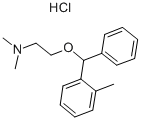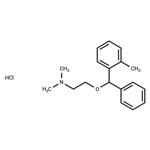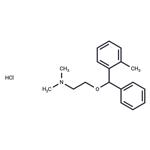Chemical Properties
White or almost white, crystalline powder.
Uses
Antihistaminic;H1 antogonist
Definition
ChEBI: A hydrochloride comprising equimolar amounts of ophenadrine and hydrogen chloride.
General Description
Odorless white or almost white crystalline powder. pH (aqueous solution) about 5.5. Bitter numbing taste.
Air & Water Reactions
May be sensitive to prolonged exposure to light and air. Water soluble.
Reactivity Profile
ORPHENADRINE HYDROCHLORIDE is incompatible with strong oxidizers.
Fire Hazard
Flash point data for ORPHENADRINE HYDROCHLORIDE are not available; however, ORPHENADRINE HYDROCHLORIDE is probably combustible.
Biochem/physiol Actions
Muscarinic receptor antagonist; H1 histamine receptor antagonist; muscle relaxant. Orphenadrine has also been reported to inhibit the noradrenergic transporter and to block the NMDA receptor ion channel.
Clinical Use
Anti-muscarinic:
Parkinsonism
Drug induced extra-pyramidal symptoms
Safety Profile
Poison by ingestion, intravenous, intraperitoneal, and subcutaneous routes. Human systemic effects: mydriasis @updlaryd ilation), hallucinations, distorted perceptions, pulse rate increase, intracranial pressure increase. An experimental teratogen. Experimental reproductive effects. When heated to decomposition it emits toxic fumes of NOx and HCl
Metabolism
Orphenadrine is almost completely metabolised to at least
8 metabolites in the liver.
It is mainly excreted in the urine as metabolites and small
amounts of unchanged drug



